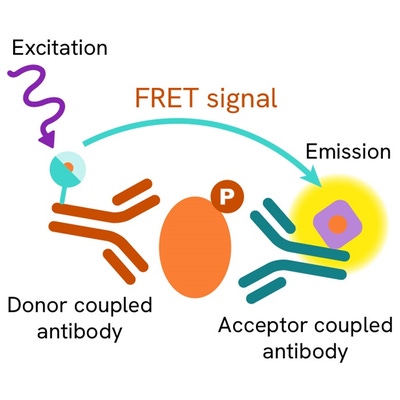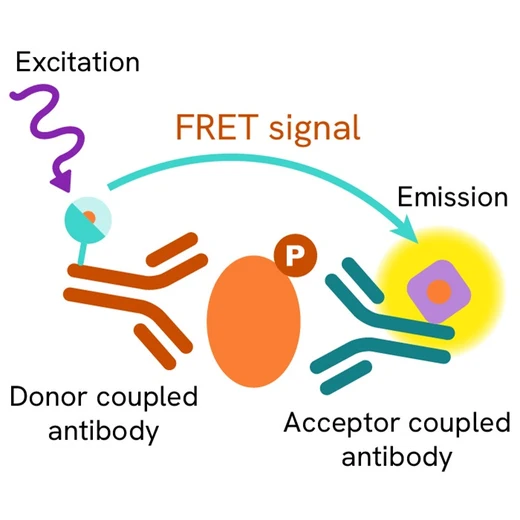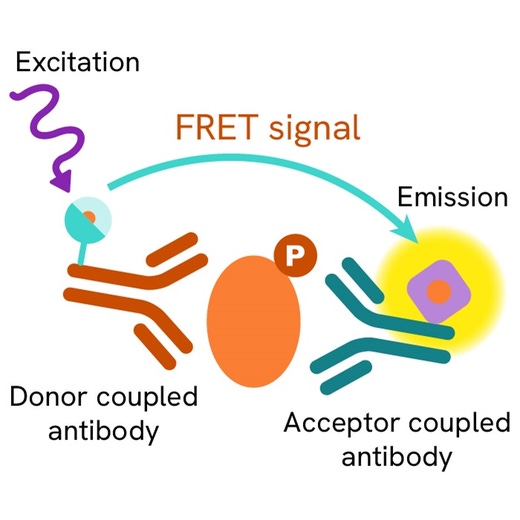

HTRF Human Phospho-AKT (Ser473) Detection Kit, 96 Assay Points








| Feature | Specification |
|---|---|
| Application | Cell Signaling |
| Sample Volume | 16 µL |









Product information
Overview
The Phospho-AKT (Ser473) kit is designed to robustly and efficiently monitor AKT phosphorylation on Ser473 across all isoforms, as a readout of Pi3K pathway activation. Also known as Protein Kinase B (PKB), AKT is an oncogene that controls apoptosis, cell proliferation, transcription, cell migration, and glucose metabolism.
How it works
Phospho-AKT (Ser473) assay principle
The Phospho-AKT (Ser473) assay measures AKT when phosphorylated at Ser473. Contrary to Western Blot, the assay is entirely plate-based and does not require gels, electrophoresis or transfer. The Phospho-AKT (Ser473) assay uses 2 labeled antibodies: one with a donor fluorophore, the other one with an acceptor. The first antibody is selected for its specific binding to the phosphorylated motif on the protein, the second for its ability to recognize the protein independent of its phosphorylation state. Protein phosphorylation enables an immune-complex formation involving both labeled antibodies and which brings the donor fluorophore into close proximity to the acceptor, thereby generating a FRET signal. Its intensity is directly proportional to the concentration of phosphorylated protein present in the sample, and provides a means of assessing the proteins phosphorylation state under a no-wash assay format.

Phospho-AKT (Ser473) 2-plate assay protocol
The 2 plate protocol involves culturing cells in a 96-well plate before lysis then transferring lysates to a 384-well low volume detection plate before adding Phospho-AKT (Ser473) assay HTRF detection reagents. This protocol enables the cells' viability and confluence to be monitored.

Phospho-AKT (Ser473) assay 1-plate assay protocol
Detection of Phosphorylated AKT (Ser473)with HTRF reagents can be performed in a single plate used for culturing, stimulation and lysis. No washing steps are required. This HTS designed protocol enables miniaturization while maintaining robust HTRF quality.

Assay validation
Phospho-AKT (Ser473) Assay IGF Dose-Response on HEK 293 cells
Results obtained on HEK cells plated using 3 cell densities (12,500 - 25,000 - 50,000 cells per well). After being starved for 24 hours, cells were stimulated for 10 minutes with various concentrations of IGF. Phosphorylated AKT was measured after 3.5 hours using the two-plate assay protocol.

Total AKT used to control the phosphorylation status of AKT (Ser473).
HEK293 cells (100,000 cells/well) were activated with IGF-1 for 10 min, using the two-plate assay protocol of the Phospho-AKT (Ser473) and Total-AKT assays. As expected, results obtained show a dose-response increase of AKT phosphorylation upon IGF-1 stimulation, while the AKT expression level remains constant.

Simplified pathway
AKT Simplified Pathway
AKT (or protein kinase B) plays a key role in controlling survival and apoptosis. This serine/threonine protein kinase is regulated by insulin and various growth and survival factors, to work in a wortmannin-sensitive pathway involving PI 3 kinase. When the Pleckstrin Homology (PH) domain of AKT binds to phosphoinositides, AKT can be phosphorylated by two different kinases, PDK1 at threonine 308 and mTORC2 (mammalian target of rapamycin) at serine 473, which switch on AKT activation.

Specifications
| Application |
Cell Signaling
|
|---|---|
| Brand |
HTRF
|
| Detection Modality |
HTRF
|
| Molecular Modification |
Phosphorylation
|
| Product Group |
Kit
|
| Sample Volume |
16 µL
|
| Shipping Conditions |
Shipped in Dry Ice
|
| Target Class |
Phosphoproteins
|
| Target Species |
Human
|
| Technology |
TR-FRET
|
| Unit Size |
96 assay points
|
Video gallery
Citations
Resources
Are you looking for resources, click on the resource type to explore further.
This guide provides you an overview of HTRF applications in several therapeutic areas.
An in-depth review of molecular and cellular pathways
The maintenance of proteostasis, the biological mechanisms that control the...
Advance your autoimmune disease research and benefit from Revvity broad offering of reagent technologies
A comprehensive listing of Type II diabetes pathways
Type II diabetes disease cases are constantly increasing, especially for...
Study your pathway of interest in PBMC and T cells
Combine models with a technique that maximizes each one’s relevance: this note...


Loading...
How can we help you?
We are here to answer your questions.






























